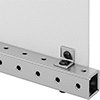Filter by
Bracket Type
Strut Channel Type
Thickness
Strut Channel Framing Component
Mount Type
Slip-On Framing Component
Bolt-Together Framing Component
Slip-On Framing Component Type
DFARS Specialty Metals
Export Control Classification Number (ECCN)
Building and Machinery Hardware
Measuring and Inspecting
Fastening and Joining


















































































